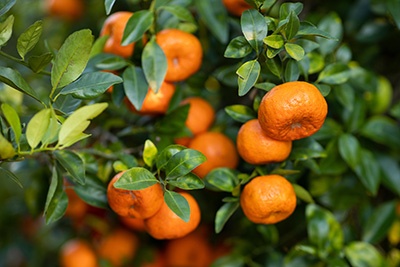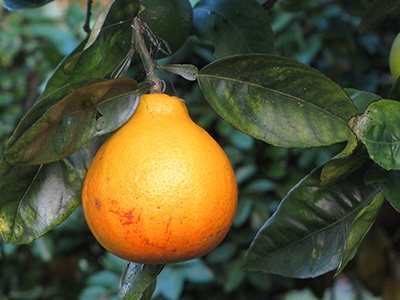
Citrus
Nearly all homeowners in Florida have the opportunity to pick citrus from their own trees. Of course, what you can grow depends on where in Florida you live. Citrus is a subtropical fruit and is limited to parts of Florida that don’t regularly experience freezing temperatures.
Careful consideration should be given to site selection, choice of variety, nutrition, and cold protection. And just like any other plant in the landscape, your citrus tree will thrive with the proper amount of water and fertilizer, weed control, and sensible pest management.
Oranges
Second only to Brazil in global orange juice production, Florida’s citrus is a $9 billion industry annually. While Valencia oranges are famous for their juice, Florida also produces Navel, Hamlin, Pineapple, and Ambersweet varieties as well.
Navel oranges are the most popular, because they can be eaten fresh or juiced. Hamlin trees produce the most oranges for juicing. Valencias provide sweet, bright-orange juice, and are considered the “king” of juice oranges in Florida. The Temple orange and the honey tangerine, which is also called the Murcott, are delicious hybrids of tangerine and sweet orange.

Tangelos
Tangelos are the sweet and juicy result of a cross between a tangerine and a grapefruit. Two varieties generally available are Orlando and Minneola (also called “Honeybells”). Tangelos are fairly cold-hardy, which makes them suitable for many parts of Florida. The tree can grow quite large, so be sure to leave plenty of room. Tangelos aren’t very self-fertile, so it helps to have a compatible citrus tree nearby, like Temple, Sunburst, or Fallglo, to ensure good pollination and high fruit yields.
Lemons and Limes
Lemons and limes are in the acid citrus group (while all citrus juice is acidic, juice from these fruits have the lowest pH). Acid fruits tend to be very cold-sensitive and are usually best suited for warmer locations in Central and South Florida.
One exception is the mellow ‘Meyer’ lemon, which is relatively cold-hardy and can be grown through the state. It has large fruit that ripens from November to March. The Meyer has a bushy growth habit and can even be grown in containers. Read more about the Meyer lemon.
- Florida Plant ID: Lemon
- Florida Plant ID: Tahiti (or Persian) Lime
- Growing Tahiti Limes in the Home Landscape
Key Lime
Another notable acid citrus is the Key lime, famous for the delicious pie it flavors. However, the Key lime tree should be grown in the warmer parts of the state, where the fruit is harvested year-round.
Key limes are tarter, smaller and more round in shape than the limes more likely to be found in grocery stores, the Tahitian lime. While key limes are no longer grown commercially in Florida, many South Florida homeowners are lucky enough to have a key lime tree of their own.

Kumquat
Kumquats are small, orange fruit with a unique “sweet-tart” flavor. Generally considered part of the citrus family, this is the only citrus that is meant to be eaten whole, including the peel, like a grape. Kumquats are cold hardy and can be grown throughout Florida. The two most popular varies are ‘Nagami’ and ‘Meiwa.’
Planting and Care
It is very important to only purchase certified nursery plants from nurseries registered with the state. Citrus trees tolerate light shade but will be more productive if grown in full sunlight. The spacing recommended should be a minimum of 15 feet between trees. Avoid planting trees too close to buildings, power lines, as well as septic tanks and drain fields. Water regularly until established. Watch young trees for any suckers that grow from the base and remove them; these shoots will interfere with tree development. Mature citrus trees do not require pruning except to remove serious disease or freeze damage. Unnecessary pruning often will reduce fruit production.
When citrus are young, fertilizer will stimulate vigorous growth of leaves and branches. After your tree is established, you’ll need to replace the nutrients that it used up in fruit production to provide enough nutrients to keep it growing. When selecting a fertilizer, choose a citrus special-type product.
Young trees should be fertilized with light but frequent doses throughout the growing season. Apply fertilizer in a three-foot-diameter circle around the tree. After the third year, fertilize your citrus four to five times per year. Fertilizer should be applied to the area directly under the tree canopy, all the way to its edge or slightly beyond. Spread the fertilizer evenly and don’t ever mound it against the trunk. See Table 2 in the EDIS publication, “HS132 Citrus Culture in the Home Landscape” for a recommended fertilizing schedule.

Growing Citrus in Containers
Even those with little space or inhospitable climates can grow citrus by planting in a container. Citrus trees that grow well in containers include limes, lemons, and kumquats. A big advantage of planting in containers is that they can be pulled in for protection from a freeze.
Citrus containers can be plastic, metal, or wood—the material doesn’t matter, as long as the container is large enough for the plant and has adequate drainage. A pot that is about fifteen inches wide and deep is a good size to start a young tree.
Most well-drained potting soils are fine for citrus, although some prefer more acidic soil. Citrus trees grow best in full sun. Water trees only when the top inch or two of the soil is dry to the touch, then water thoroughly. Your tree will require very little pruning except to remove stray branches or lower limbs.
Harvesting Your Citrus
Many citrus varieties are ready to harvest in January, including navel oranges, Satsuma tangerines, and Ruby Red grapefruits.
If you’re growing other varieties, do a little research to confirm the best time to harvest them.
To pick fruits from the tree, just use a pull-snap-twist motion. Remember to taste one or two fruits for ripeness before you harvest the whole tree, since citrus fruit will not continue to ripen after they’ve been picked.
Wash the fruit when you’re ready to eat them but not before. This preserves their natural wax and prevents them from drying out.
A neat trick is that you can also store ripe fruit on the tree for a few months. They usually get even sweeter, and you’ll be able to enjoy fresh, homegrown citrus for a longer period of time.
For more information about dooryard citrus, please contact your county Extension office.
